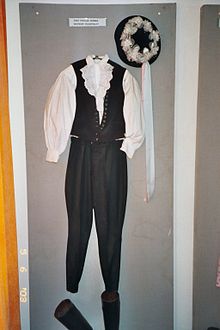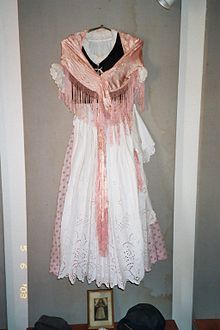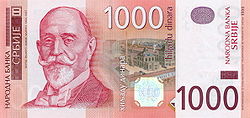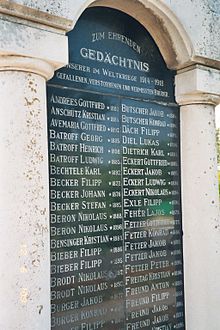- Danube Swabians
-
The Danube Swabians (German: Donauschwaben) is a collective term for the German-speaking population who lived in the former Kingdom of Hungary, especially alongside the Danube River valley. Because of different developments within the territory settled, the Danube Swabians cannot be seen as a unified people. They include the Germans of Hungary, Satu Mare Swabians, the Banat Swabians, and the Vojvodina Germans in Serbia's Vojvodina who called themselves Shwoveh, and Croatia's Slavonia (especially in Osijek region). The Carpathian Germans and Transylvanian Saxons are not included within the Danube Swabian group.
Contents
History
 Danube Swabian men's tracht, from the historic house of the parents of Stefan Jäger, Hatzfeld (Jimbolia), Romanian Banat.
Danube Swabian men's tracht, from the historic house of the parents of Stefan Jäger, Hatzfeld (Jimbolia), Romanian Banat.
Origins
Beginning in the 12th century, German merchants and miners began to settle in the Kingdom of Hungary at the invitation of the Hungarian monarchy (see Ostsiedlung). Although there were significant colonies of Carpathian Germans in the Spiš mountains and Transylvanian Saxons in Transylvania, German settlement throughout the rest of the kingdom had not been extensive until this time.
During the 17th-18th centuries, warfare between the Habsburg Monarchy and the Ottoman Empire devastated and depopulated much of the lands of the valley, referred to geographically as the Pannonian plain. The Habsburgs ruling Austria and Hungary at the time resettled the land with people of various ethnicities from the Austro-Hungarian Empire of the Habsburgs including Magyars, Czechs, Slovaks, Croats, Serbs, Romanians, Ukrainians, and Germanic settlers from Swabia, Hesse, Franconia, Bavaria, Austria, and Alsace-Lorraine. However, despite their origin, they were all referred to as Swabians by their neighbor Serbs, Hungarians, and Romanians. The Batschka settlers called themselves Shwoveh, the plural of Shwobe in the polyglot language that evolved there. The majority of them went on board in Ulm Swabia and came to their new destination on the Danube with a kind of boats called Ulmer Schachteln.
Settlement
The first wave of resettlement came as the Ottoman Turks were gradually being forced back after their defeat at the Battle of Vienna in 1683. The settlement was encouraged by nobility whose lands had been devastated through warfare, and by military officers including Prince Eugene of Savoy and Claudius Mercy. Many Germans settled in the Bakony (Bakonywald) and Vértes (Schildgebirge) mountains north and west of Lake Balaton (Plattensee), as well as around the town Buda (Ofen), now part of Budapest. The area of heaviest German colonization during this period was in the Swabian Turkey (Schwäbische Türkei), a triangular region between the Danube river, Lake Balaton, and the Drava (Drau) River. Other areas settled during this time by Germans were Pécs (Fünfkirchen), Satu Mare (Sathmar), and south of Mukachevo (Munkatsch).
After the Banat area of Central Europe was annexed from the Ottomans by the Habsburgs in the Treaty of Passarowitz (1718), plans were made to resettle the region, which became known as the Banat of Temesvár (Temeschwar/Temeschburg), as well as the Bačka (Batschka) region between the Danube and Tisza (Theiss) rivers. Fledgling settlements were destroyed during another Austrian-Turkish war (1737–1739), but extensive colonization continued after the suspension of hostilities. The resettlement was accomplished through private and state initiatives. After Maria Theresa of Austria assumed the throne as Queen of Hungary in 1740, she encouraged vigorous colonization on crown lands, especially between Timişoara and the Tisza. The Crown agreed to permit the Germans to retain their language and religion (generally Roman Catholic). They steadily redeveloped the land: drained marshes near the Danube and the Tisza, rebuilt farms, and constructed roads and canals. Many Danube Swabians served on Austria's Military Frontier (Militärgrenze) against the Ottomans. Between 1740 and 1790, more than 100,000 Germans immigrated to the Kingdom of Hungary.
The Napoleonic Wars ended the large-scale movement of Germans to the Hungarian lands, although the colonial population increased steadily and was self-sustaining through reproduction. Small daughter-colonies developed in Slavonia and Bosnia. After the creation of Austria-Hungary in 1867, Hungary established a policy of Magyarization whereby minorities, including the Danube Swabians, were induced by political and economic means to adopt the Magyar language and culture.
Beginning in 1893, Banat Swabians began to move to Bulgaria, where they settled in the village of Bardarski Geran, Vratsa Province, founded by Banat Bulgarians several years prior to that. Their number later exceeded 90 families. They built a separate Roman Catholic church in 1929 due to conflicts with the Bulgarian Catholics. Some of these Germans later moved to Tsarev Brod, Shumen Province, together with a handful of Banat Bulgarian families, as well as to another Banat Bulgarian village, Gostilya, Pleven Province.
Between 1941 and 1943, a total of 2,150 ethnic German Bulgarian citizens were transferred to Germany as part of Adolf Hitler's Heim ins Reich policy. These included 164 Banat Swabians from Bardarski Geran and 33 from Gostilya.[1]
After the treaties of Saint-Germain (1919) and Trianon (1920) following World War I, the Banat was divided between Romania, Yugoslavia, and Hungary; Bačka was divided between Yugoslavia and Hungary; and Satu Mare went to Romania. Before World War II, the biggest populations of Germans in the Vojvodina were at Hodschag, Werbass, and Apatin.
Although precise figures are not available, scholars believe that there may have been approximately one million ethnic Danube Swabians in the region before World War II. In 1935 the scholar Paul Gauss asserted there were around 500,000 in Hungary, 450,000 in the Vojvodina, and between 230 to 300,000 in the Romanian Banat area, with an additional 60,000 in Satu Mare (Sathmar).
World War II, expulsion, and current situation
See also: Yugoslav Front, 7th SS Volunteer Mountain Division Prinz Eugen, Banat (1941-1944), and Independent State of CroatiaIn 1941 Yugoslavia was invaded and occupied by Nazi Germany, and in the German occupied Banat the Swabian minority was granted a status of superiority over the other ethnic groups in the Yugoslav population. The Baranja and Bačka Swabians reverted to Hungary, to their general disappointment. [2] The Danube Swabians were already under heavy Nazi influence by that time and served as the Axis fifth column during the invasion of Yugoslavia, although many served in the royal Yugoslav army in the brief war against the Nazis in April, 1941 .[3] The Independent State of Croatia (1941-1945), a fascist puppet state[4][5] created within Axis-occupied Yugoslavia, was home to 182,000 Danube Swabian Volksdeutche ("Folksdojčeri" in Serbo-Croatian).[6] In addition, the Danube Swabian minority were granted a separate autonomous region of Banat within German-occupied Serbia (another part of occupied Yugoslavia), in which they ruled over the Slavic majority (Danube Swabians formed around 20% of the population[7]). "With rare exceptions", the Yugoslav Danube Swabians collaborated wholeheartedly with the occupation, supplying more than 60,000 troops for German military formations both voluntarily and under duress, and actively participating in the brutal repression of the Yugoslav partisans.[3]
The local collaborationist authorities were forced to make it illegal to draft Danube Swabians. However, of the approximately 300,000 strong Danube Swabians minority in occupied Yugoslavia (182,000 in the NDH, 350,000 in Vojvodina, 500,000 in Romania and 500,000 in Hungary), approximately 100,000 eventually entered service in various German and Axis military organizations, most notably in the two locally formed Waffen-SS volunteer divisions, the 7th SS Volunteer Mountain Division Prinz Eugen, and the 22nd SS Volunteer Cavalry Division Maria Theresa (which was made-up of Hungarian Danube Swabians ). The 7th SS Prinz Eugen in particular, one of the most infamous SS units of World War II, was to be responsible for the massacres of tens of thousands of Yugoslav civilians, as well as brutal reprisals resulting in the desolation of entire areas.[3] The 7th SS Prinz Eugen was principally engaged in fighting the Partisans, the Allied resistance military of Yugoslavia, often in cooperation with the Chetniks, the royalist Yugoslav forces. The division became notorious for its numerous atrocities against the Yugoslav civilian population, particularly during the battles of the Neretva and Sutjeska (1943), including the killing of all captured prisoners and wounded.[8] The division was also responsible for large-scale atrocities committed in the area of Nikšić in Montenegro:
Everything they came across they burnt down, they murdered and pillaged. The officers and men of the SS division Prinz Eugen committed crimes of an outrageous cruelty on this occasion. The victims were shot, slaughtered and tortured, or burnt to death in burning houses. Where a victim was found not in his house but on the road or in the fields some distance away, he was murdered and burnt there. Infants with their mothers, pregnant women and frail old people were also murdered. In short, every civilian met with by these troops in these villages was murdered. In many cases, whole families who, not expecting such treatment or lacking the time for escape, had remained quietly in their homes were annihilated and murdered. Whole families were thrown into burning houses in many cases and thus burnt. It has been established from the investigations entered upon that 121 persons, mostly women, and including 30 persons aged 60-92 years and 29 children of ages ranging from 6 months to 14 years, were executed on this occasion in the horrible manner narrated above. The villages [and then follows the list of the villages] were burnt down and razed to the ground.—Dr. Dušan Nedeljković, Yugoslav State Commission, Document D-940, [9]Although these formations were initially formed as volunteer units,[3] ultimately conscription had to be imposed by SS officials under the dubious legal pretext that occupied Serbia was deutsches Hoheitsgebiet and the archaic Tiroler Landsturmordung (Tyrol General Levy Act) of 1872 was introduced.[10] The 7th SS Prinz Eugen was thus formed as a volunteer formation, but historians have demonstrated that later in the war the local German authorities of Banat came under significant pressure from the German authorities. Essentially coercion was used to recruit more troops. Dr Guenther Reinecke, chief of the Hauptamt SS-Gericht (SS legal office) wrote to Himmler that the Prinz Eugen was "no longer an organization of volunteers, that on the contrary, the ethnic Germans from Serbian Banat were drafted, to a large extent under threat of punishment by the local German leadership, and later by the SS Erganzsamt."[11]
During the Nuremberg trials, a photograph of SS troopers (of low rank) decapitating a Yugoslav civilian with a woodsman's axe was shown. When asked to account for the atrocities of the 7th SS, the SS Oberstgruppenführer Paul Hausser (second in command of the SS) stated in explanation that the division was composed primarily of Yugoslav Germans, many trained (under conscription) in the pre-war royal Yugoslav army.[12] Of about 100,000 Danube Swabians who served in the various SS units, approximately 29,000 were killed. This total includes 2,000 POWs from the 7th SS Prinz Eugen who were summarily executed by the Allied Yugoslav troops as Yugoslav citizens collaborating with the enemy.[citation needed]
In 1944, a joint advance of the Yugoslav Partisans, and the Soviet Red Army saw the liberation of northern areas of German-occupied Yugoslavia, which were home to the Danube Swabian minority. In Yugoslavia in particular, with rare exceptions the Danube Swabian minority "collaborated wholeheartedly with the occupation".[3] Consequently, on November 21, 1944 the Presidium of the AVNOJ (the Yugoslav parliament) declared the German minority in Yugoslavia collectively hostile to the Yugoslav state. [13] The AVNOJ Presidium issued a decree that ordered the government confiscation of all property of Nazi Germany and its citizens in Yugoslavia, persons of German nationality (regardless of citizenship), and collaborators. The decision acquired the force of law on February 6, 1945.[14] The many reasons for this announcement are still inaccessible to historians, but the expropriation of Swabian agricultural lands to facilitate collectivization appears to have been a prime reason. [15]
During the Second World War, many of the Germans sent the youngest and the oldest of their families to Germany. From 1945-48, many Germans in Hungary were dispossessed and forced to emigrate to Allied-occupied Germany. In the Batschka which had been part of Hungary from 1941, Shwovish villages were emptied forcibly in March of 1945 and the old and the young were imprisoned in Yugoslavian starvation camps in Gakovo, Kruševlje, Rudolfsgnad (Knićanin), Molidorf (Molin), Bački Jarak, Krndija, Valpovo and Sremska Mitrovica. [16]. Those able to work were used as slave labor throughout the countryside. Of a pre-war population of about 350,000 in the Vojvodina the 1958 census revealed 32,000 left. Officially, Yugoslavia denied the forcible starvation and killing of their Shwovish populations, but reconstruction of the death camps reveals that of the 170,000 Danube Shwabians interned from 1944 to 1948, about 50,000 died of mistreatment. [17] Since only families with the very young (under three), very old, and mothers were interned and starved, many others were unaccounted in slave labor settings throughout the countryside; but their death rates were probably much lower. The Germans in Romania were not deported but were instead dispersed within Romania. Many left Romania for West Germany between 1970-90, and this trend increased in 1990. Beginning in 1920 and especially after World War II, many Danube Swabians migrated to the United States, Brazil, Canada, Austria, Australia, and Argentina. Some of them, descending from French-speaking or linguistically mixed families from Lorraine, had maintained for some generations the French language, and a specific ethnic identity, later labelled as Banat French, Français du Banat, and were resettled in France around 1950.[18]
Culture
 Danube Swabian women's tracht, from the historic house of the parents of Stefan Jäger, Hatzfeld (Jimbolia), Romanian Banat.
Danube Swabian women's tracht, from the historic house of the parents of Stefan Jäger, Hatzfeld (Jimbolia), Romanian Banat.
The Danube Swabian culture is a melting pot of southern German regional customs, with a large degree of Balkan and mostly Hungarian influence. This is especially true of the food, where paprika is heavily employed, which led to the German nickname for Danube Swabians as Paprikadeutsche. The architecture is neither Southern German nor Balkan but is unique to itself. The houses, often made of stamped mud and straw walls or mud bricks, are ubiquitous throughout the Vojvodina region. Georg Weifert was responsible for developing one of the most famous beers in the Serbia/Yugoslavia region and later became an important banker and politician in Belgrade (his image currently features on the Serbian 1000 dinar note).
 Weifert on the 1000 Serbian dinar bill.
Weifert on the 1000 Serbian dinar bill.
Language
The Danube Swabian language is only nominally Swabian (Shwovish in the Batschka). In reality, it contains elements or many dialects of the original German settlers, mainly Swabian, Franconian, Bavarian, Rhinelandic/Pfälzisch, Alsatian, and Alemannic, as well as Austro-Hungarian administrative and military jargon. Loanwords from Hungarian, Serbian, or Romanian are especially common regionally regarding cuisine and agriculture, but also regarding dress, politics, place names, and sports. Other cultures of influence include Serbian and Croatian, Russian (for communist concepts), Romanian, Turkish (Hambar), English (for football), and general Balkan and South Slavic loanwords like Kukuruts (corn) or "Grumbiere" {potatoes} [this is not accurate: 'Kukuruz' is used in Austria and 'Grumbiere' derives from 'Grundbirne' (lit. 'Ground pears') and is common in Allemanic and Rhenish German dialects] B. The plural of loanwords is in most cases formed in the Danube Swabian way. Conjunctions and adverbs from the respective contact languages may be integrated as well.[19]
Many German words used by speakers of Danube Swabian dialects may sound archaic. To the ear of a Standard German speaker, the Danube Swabian dialect sounds like what it is: a mix of southwestern German dialects from the 18th century. Due to relative isolation and differing proximities to nearby German speakers (Austrians and Transylvanian Saxons), the language varies considerably, with speakers able to distinguish inhabitants of neighboring villages by the words they use for such things as marmalade (Schleckle being one variant), or by how many (usually Hungarian) loanwords they employ. Herman Ruediger, a German sociologist, reports that in his trips throughout the Batschka in the 1920s, he noted that Danube Swabians from widely separated villages had to use standard high German to communicate with each other because their speech was so different.[20]
Naming
As is the custom in Hungary, Danube Swabians often put the surname first, especially when writing, for example Butscher Jakob (see photo of memorial). Danube Swabian villages tend to have relatively few family names as the villagers stem from only a few families, but usually the same family name does not appear in more than a couple of villages, meaning that there are many Danube Swabian family names. The names come from throughout southern Germany, from assimilated Hungarians, and occasionally from Balkan and Italian origins. There are usually no middle names, but often double first names, if a distinction can be made. The variety of first names is few, since children were usually named after grandparents or godparents. Popular names for women include: Anna, Barbara, Christina, Katharina, Magdalena, Maria, Sophia, Theresia, and many two-name combinations thereof. Popular names for men include: Adam, Christian, Friedrich, Georg, Gottfried, Heinrich, Jakob, Johann, Konrad, Ludwig, Mathias, Nikolaus, Peter, Philipp (or Filipp), and Stefan (or Stephan). With so few names in villages, other modifiers or nicknames were almost always used to distinguish people. The modifiers were often size related (e.g., "Kleinjohann" or "Little Johann"), occupation related, or location related (usually by prefixing the streetname).
Coat of arms
A coat of arms designed in 1950 by Hans Diplich has been adopted by many Danube Swabian cultural organizations. Its blazon is "Parti per fess wavy 1 Or, an eagle displayed couped Sable langued Gules; 2 parti per fess Argent and Vert, a fortress Argent roofed and turreted Gules surmounted with Sun and Crescent waning Or; chief wavy Azure".
It depicts:
- a black eagle representing the protection of the Emperor of Austria;
- a blue ribbon representing the Danube River;
- a crescent moon representing the waning of Islamic influence through the withdrawal of the Ottoman Turks;
- the Sun representing both Prince Eugene of Savoy and the light of Christianity; and
- a fortress representing the fortified city of Temeschburg (Timişoara).
Resources for genealogical research
Germany
- Institut für Auslandsbeziehungen Stuttgart; (institute of foreign relations); church records (microfilm) of villages in the banat
Austria
- Theresianischer Kataster, Österreichisches Staatsarchiv, Finanz- und Hofkammerarchiv; Austrian archive
Luxembourg
- Institut Grand-Ducal, Section de Linguistique, d’Ethnologie et d’Onomastique, village chronics and family records
- Centre de Documentation sur les Migrations Humaines
- Nationalarchiv Luxemburg, Microfilms, notary records, church records
See also
- Expulsion of Germans after World War II
- Banat Swabians
- Ethnic German
- Volksdeutsche
- Carpathian Germans
- Baltic Germans
- Transylvanian Saxons
- Volga Germans
- Georg Weifert
References
- ^ Njagulov, Blagovest (1999). "Banatskite bǎlgari v Bǎlgarija" (in Bulgarian). Banatskite bǎlgari: istorijata na edna malcinstvena obštnost vǎv vremeto na nacionalnite dǎržavi. Sofia: Paradigma. ISBN 954-9536-13-0.
- ^ Tomasevich 1975.
- ^ a b c d e Tomasevich, Jozo; War and revolution in Yugoslavia, 1941-1945: occupation and collaboration, Volume 2; Stanford University Press, 2001 ISBN 0-8047-3615-4 [1]
- ^ Independent State of Croatia - Britannica Online Encyclopedia
- ^ Yugoslavia, Holocaust Encyclopedia, United States Holocaust Memorial Museum
- ^ [2] Pavlowitch, Stevan K. "Hitler's New Disorder" Columbia University Press, 2008
- ^ http://www.hic.hr/books/jugoistocna-europa/02tablice.htm
- ^ [3] Wolff, Stefan. "German minorities in Europe", Berghahn Books, 2000
- ^ http://www.nizkor.org/hweb/imt/tgmwc/tgmwc-20/tgmwc-20-196-02.shtml
- ^ George H. Stein, The Waffen-SS, Hitler's Elite Guard at War 1939-1945, (Cornell University, 1966), page.172.
- ^ George H. Stein, The Waffen-SS, Hitler's Elite Guard at War 1939-1945, Cornell University, 1966, p. 171.
- ^ Stein, George H.; The Waffen SS: Hitler's elite guard at war, 1939-1945; Cornell University Press, 1984; p. 274; ISBN 0-8014-9275-0
- ^ Ramet 2006, p. 159.
- ^ Tomasevich 1969, p. 115, 337.
- ^ Janjetović, Zoran: Between Hitler and Tito. The Disappearance of the Vojvodina Germans, Belgrade 2005 (2nd ed.)
- ^ Janjetović, Zoran: Between Hitler and Tito. The Disappearance of the Vojvodina Germans, Belgrade 2005 (2nd ed.)
- ^ Janjetović, Zoran: Between Hitler and Tito. The Disappearance of the Vojvodina Germans, Belgrade 2005 (2nd ed.)
- ^ Smaranda Vultur, De l’Ouest à l’Est et de l’Est à l’Ouest : les avatars identitaires des Français du Banat, Texte presenté a la conférence d'histoire orale "Visibles mais pas nombreuses : les circulations migratoires roumaines", Paris, 2001
- ^ Bentz, Michaela (2008). German as a Minority Language: The "Swabians" in the Danubian States and their Language(s). In: Kokkonidis, Miltiadis (ed.), Proceedings of LingO 2007, pp.20-26
- ^ Ruediger, H. (1931) Die Donauschwaben in der südslawischen Batschka, Schriften des Deutschen Ausland-Instituts Stuttgart. Reihe A. Bd. 28. Stuttgart, 1931
- Krallert, Wilfried (1958). Atlas zur Geschichte der deutschen Ostsiedlung. Bielefeld: Velhagen & Klasing.
- Valdis O. Lumans, Himmler's Auxiliaries: The Volksdeutsche Mittelstelle and the German National minorities of Europe, 1939-1945 (University of North Carolina Press, 1993), page.235.
External links
- Danube Swabian Resources
- Landesverband der Donauschwaben, USA OFFICIAL WEBSITE
- Genocide of The Ethnic Germans in Yugoslavia 1944-1948
- History of the Danube Swabians
- DVHH - Donauschwaben Villages Helping Hands
- Totenbuch der Donauschwaben - List of Danube Swabians killed after World War II
Ethnic groups in Serbia Central Serbia Serbs · Albanians · Bosniaks · Ethnic Muslims · Bulgarians · Croats · Macedonians · Montenegrins · Roma · Romanians (Vlachs) · YugoslavsVojvodina Banat Bulgarians · Bunjevci · Croats (Šokci) · Germans (Danube Swabians and Banat Swabians) · Hungarians (Szekelys) · Montenegrins · Macedonians · Pannonian Rusyns · Roma · Serbs · Slovaks · Yugoslavs · Romanians · Czechs · Slovenes · Gorani people · Ukrainians · Albanians · RussiansKosovo[a] ^a Kosovo is the subject of a territorial dispute between the Republic of Serbia and the self-proclaimed Republic of Kosovo. The latter declared independence on 17 February 2008, while Serbia claims it as part of its own sovereign territory. Its independence is recognised by 85 UN member states.German people Historical 
Diaspora EuropeTransylvanian Saxons / Landler · Danube / Banat / Satu Mare Swabians · Dobruja · Zipser · Regat · Bessarabia · BukovinaElsewhereCzech Republic (Sudetenland) · Hungary · Bessarabia · Poland · Russia (Volga · Russian Mennonite) · Slovakia · Slovenia (Gottschee County) · Ukraine (Black Sea · Bukovina · Crimea)Balkans and SoutheasternElsewhereArgentina · Bolivia · Brazil · Canada (Hutterites) · Chile · Cuba · Jamaica · Mexico · Paraguay · Peru · United States (Pennsylvania Dutch · Texas · Palatines · Puerto Rico)AfricaNamibia · South Africa (Afrikaners)AsiaOceaniaSee also Categories:- Bačka
- Banat
- Danube-Swabian people
- Ethnic groups in Europe
- Ethnic groups in Bulgaria
- Ethnic groups in Croatia
- Ethnic groups in Serbia
- Ethnic groups in Vojvodina
- Forced migration
- German diaspora
- History of Austria
- History of Bulgaria
- History of Croatia
- History of Germany
- History of Hungary
- History of Romania
- History of Serbia
- History of Vojvodina
- Swabia
Wikimedia Foundation. 2010.

